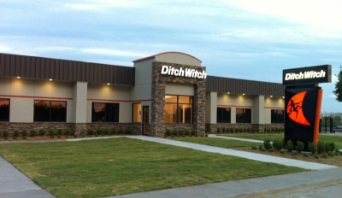By Cory Maker, Ditch Witch Product Manager, Drill Pipe and Fluid Management
Featured in: Dig Different
Profitability on a horizontal directional drilling (HDD) project hinges on a productive crew. And a key component of productivity and continuous performance is having the right equipment for the job. For example: it is important to use a drill with enough torque for the ground conditions in which you’re operating, or to ensure the drill being used has enough space to setup and shoot out an entrance path.
Even when you have drills suited to the jobsite, however, roadblocks can keep you from getting the most out of your equipment. Proper HDD tooling can help. Before ground breaks, you can make tooling selections that speed product deployment and help keep your company profitable.
Design Considerations #
HDD projects require equipment tailored to the job, such as features that help when shooting out long bores or systems tools that help when boring in challenging ground conditions. Matching the drill, as well as the drill pipe, to the jobsite is a recommended initial step for any underground project. Just as important, but often overlooked, is also fitting the drill and the drill pipe to make sure they effectively work well together.
Manufacturing specialization can impact efficiency. So, manufacturers focused exclusively on drill pipe have advanced the life of the pipe, designing a variety of options suited to almost anything that will be encountered underground.
When directional drill manufacturers are not responsible for drill pipe design for their own drills, however, they’re required to design a drill to fit specific pipe specifications. For example, the unit must be designed to meet a specified makeup torque to properly assemble the drill string. And, unless both drill pipe and drill were designed together, it’s difficult to match a specific thread profile to the drill that will use it.
The result of this mismatch is that the drill will have too much or too little rotary torque for the drill pipe, since every drill pipe is designed to handle a specific makeup torque. When the drill has too much torque, operators need to de-rate the machine’s engine to achieve the proper makeup and thrust levels. For instance, a drill capable of 40,000 lbs of torque will run at 28,000 lbs because of the pipe’s limitations. Another consequence of the mismatch is sending too much power downhole, causing worn drill pipe to break more easily. When there is too little torque, however, the drill lacks the power needed to makeup the pipe correctly. Pipe can begin breaking loose while drilling.
These issues can be greatly reduced by making sure drill pipe and the drill are designed to work together. Not only will this intentional design help ensure you have the right makeup torque for your tooling, but additional enhancements can then also be built into the HDD equipment.
One such enhancement is coordinated drill-pipe makeup. When designing pipe with an intended thread profile, the drill can automatically set the speed and feed for makeup. This simplified, automated process helps extend the life of the thread.
Heightened Standards in Forged Pipe #
As we know, HDD equipment selection is key to productivity and matching drill pipe is a critical element. To further enhance gains on HDD projects, consider utilizing forged drill pipe, designed for the drill. Forged pipe lasts longer and helps minimize the risk of losing HDD tooling downhole.
Due to set industry standards, all forged drill pipe, regardless of manufacturer, is often considered to be of the same quality. Each pipe, for instance, will be made from a single piece of AISI 4130 steel that satisfies the S-135 tubing grade requirements. Double shoulder connections, which enhance the performance of connections, are also becoming common on HDD jobsites.
Those industry standards, however, don’t specify the thickness of drill pipe. Operators often want stiff forged drill pipe because it helps them steer more effectively. The stiffer the pipe, the less likely an operator will get flex out of the bore when pushing downhole.
The trade-off is stiffer pipe is often thicker, which can negatively impact the bend radius. Manufacturers such as the Ditch Witch® organization, however, design forged drill pipe to the industry standards and tubing grade requirements, but thicker than competitive pipe, while maintaining a desired bend radius.
Additionally, for Ditch Witch Forged Drill Pipes, wear indicator grooves designed into the forged drill pipe provides the operator visual indication of wear allowances that are beyond the typical industry standards. Often operators will have to visually inspect their threads and visually hunt for breaks or wear, which can involve estimating the pipe’s remaining life. Indicator grooves, however, indicate the wear on the tool joint, helping operators more accurately determine the degree of wear, and better predict when replacements are required.
Finally, by designing drill pipe for the machines, and forging the drill pipe with solid, U.S.-made steel, manufacturers like Ditch Witch have extended the life of drill pipe beyond industry averages. Next to comparable offerings, these tool joints have up to four times the life.
Matching HDD equipment and expecting higher standards from forged drill pipe offers you new approaches to enhancing jobsite productivity. Time is money on the job, and by getting the most out of equipment, crews will be able to reduce unexpected roadblocks like excessive time spent calibrating or inspecting equipment.
For more information on Ditch Witch drill pipe, visit Drill Pipe | Ditch Witch – Directional Drills, Trenchers, Vacs, & Skid Steers






